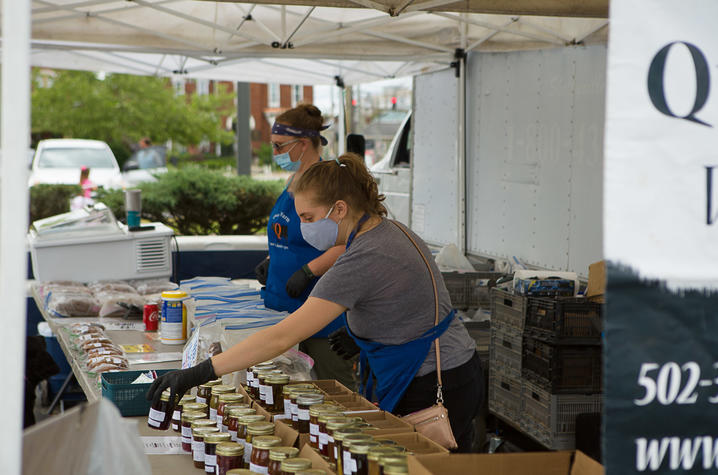UK Leads National Team Studying Pandemic’s Effect on Local Food Systems

LEXINGTON, Ky. (June 11, 2020) — The U.S. Department of Agriculture’s Agricultural Marketing Services Division is partnering with the University of Kentucky, Colorado State University and Penn State University on a $1 million cooperative research agreement to conduct a national study on the COVID-19 pandemic’s effects on local food systems.
Co-principal investigators Lilian Brislen and Tim Woods of the UK College of Agriculture, Food and Environment will partner with the USDA to lead the team of researchers. Also included in the study are 16 trade association partner organizations from around the country that represent various sectors of the food industry.
The study seeks to answer how sectors of local and regional food systems are responding to COVID-19, what successful adaptations have been implemented, what obstacles the various arms of local food systems have encountered and the economic and value-chain impacts.
The closure of schools, universities and restaurants due to safety measures enacted to slow the spread of COVID-19 has taken a considerable toll on local and regional food markets. The National Sustainable Agriculture Coalition estimates a loss in farmers markets’ annual sales of 10% to 25%, a 10% loss in farm-to-school sales, and 20% loss in food hubs and restaurant sales due to the coronavirus. Based on the USDA Agricultural Marketing Services’ Local Food Impact calculator, this would lead to an estimated loss of $632 million to $1.18 billion to local economies.
Until now, a national platform to bring resources together for local and regional food systems stakeholders has been lacking. The yearlong study will create such a platform by fostering cross-sector collaboration, conducting marketplace assessments and capturing production and marketing strategies and innovations. The resulting information will be posted online in the form of webinars, guides, fact sheets, case studies and resources to help producers have a voice in shaping future USDA response programs.
“There are many different players, and local food looks different in different contexts,” said Brislen, executive director of The Food Connection @ UK. “We want to understand the differences and similarities in how local food systems are being impacted by the COVID-19 pandemic. If we’re talking about food hubs that supply local food to institutional dining or niche meat processors, what kinds of impacts are those businesses experiencing and how are they adapting and innovating? How do we, as the research team, capture those innovations as they occur and share them back out to the broader local food community?”
Though smaller, local and short supply chain systems are more vulnerable to crises such as the pandemic, they are often more nimble than the big players when it comes to being able to redirect their product.
“The smaller-scale producers have been able to make silk purses out of sows’ ears, so to speak, in some instances, redirecting their product to other markets where market demand has expanded,” said Woods, UK extension professor in the Department of Agricultural Economics.
For instance, Woods has seen an unexpected surge in the demand for local products since the pandemic began in the United States, which has positively impacted CSAs and farmers markets.
“Many direct markets like farm markets and CSAs are seeing a surge in consumer interest. Other aspects of local food markets are struggling. We have an opportunity in this project to hear from grocers, restaurants, schools, agritourism and farm groups to help forge a path forward together,” he said.
The end result of the study, besides providing a national platform of information, is that the AMS will have a conduit of communication throughout the country that will help them design support programs for local food.
“How do we need to change the way we support and strengthen local food systems that certainly have a lot of strengths and resilience to them but are also faced with unique challenges?” Woods said. “How might federal programs be better designed to help? Is it more market information, is it different kinds of insurance and support, is it help with branding and promotion or distribution infrastructure? There are a lot of ways I think this project is going to be able to help the folks who are working in the local food system to be able to connect with the USDA.”
As the state’s flagship, land-grant institution, the University of Kentucky exists to advance the Commonwealth. We do that by preparing the next generation of leaders — placing students at the heart of everything we do — and transforming the lives of Kentuckians through education, research and creative work, service and health care. We pride ourselves on being a catalyst for breakthroughs and a force for healing, a place where ingenuity unfolds. It's all made possible by our people — visionaries, disruptors and pioneers — who make up 200 academic programs, a $476.5 million research and development enterprise and a world-class medical center, all on one campus.




